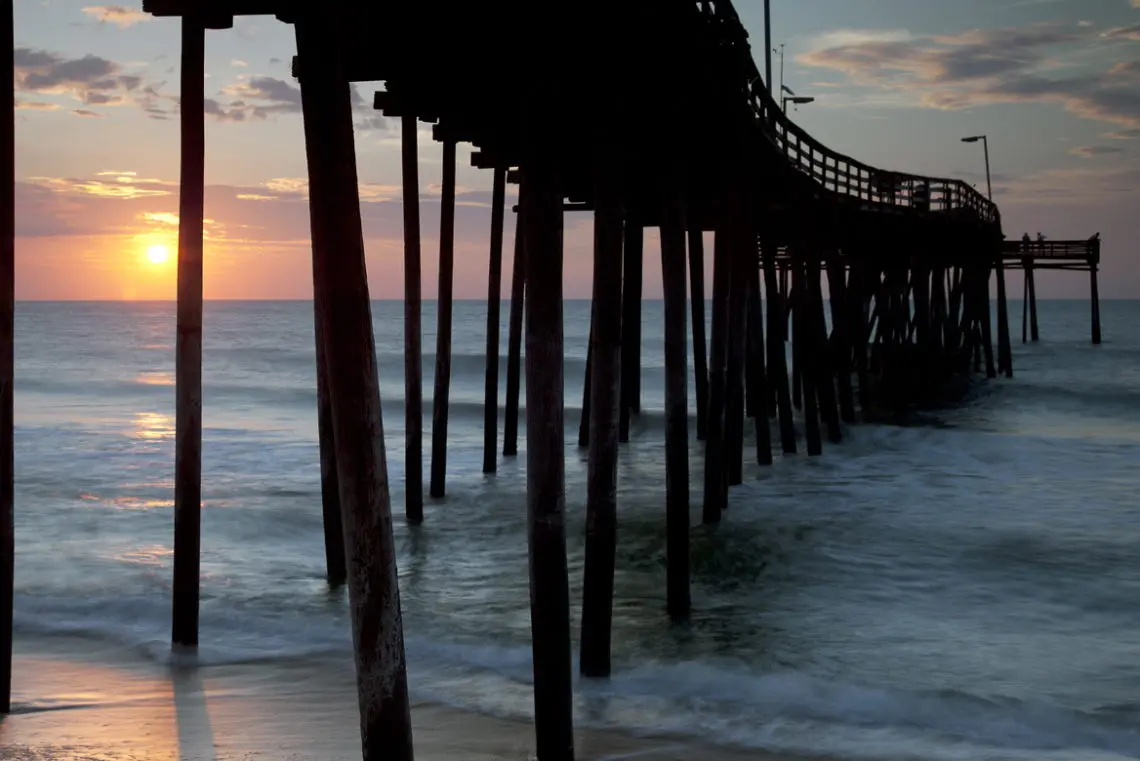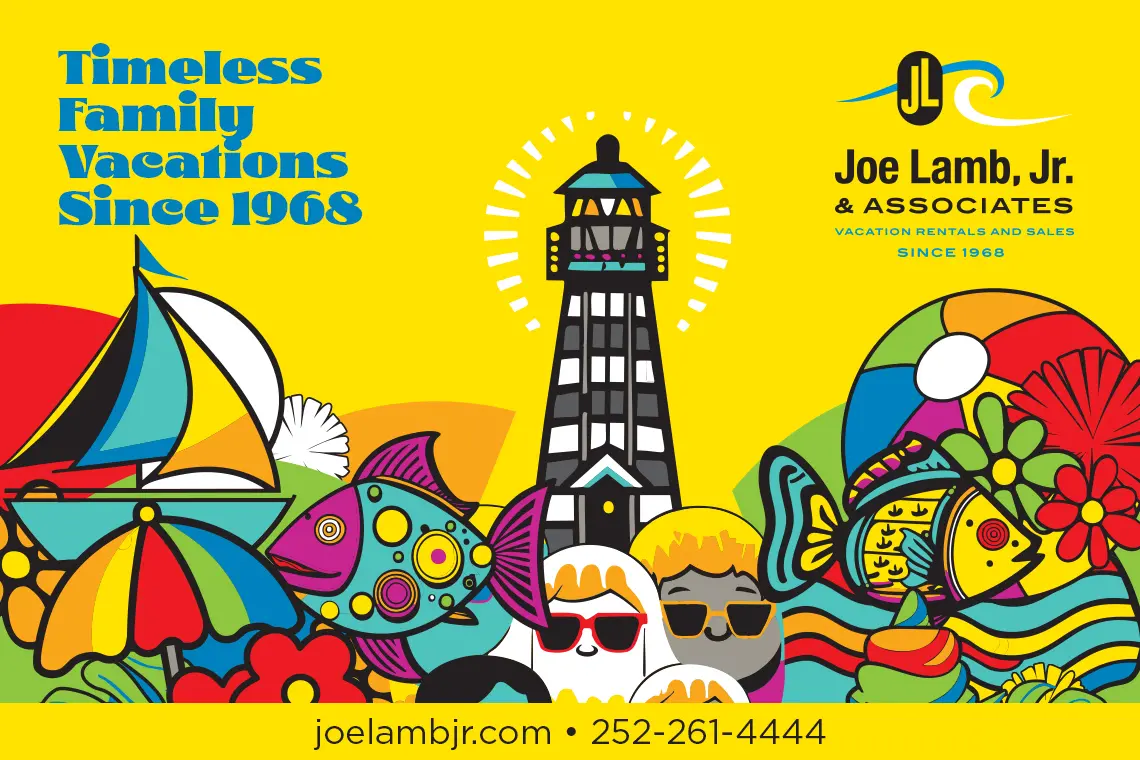As late as 1975, the tiny village of Corolla was the most remote of the Outer Banks townships. It was accessible only by boat or by driving on the open beach at low tide. It consisted of a post office, a church, school, and several private residences. The Currituck Lighthouse, the northernmost of the NC coastal lighthouses, and a lifesaving station were the only man-made structures visible from the shoreline. Telephone service and electricity were unheard of here until the late 1960s, and the locals made their living as they had for hundreds of years, from fishing or hunting.
That all changed in 1984 when Highway 12, which once terminated at the Dare County line just above Duck, was extended north to Corolla. In the 15 years since the road was extended, a development boom has taken place in Corolla. Resorts and planned vacation neighborhoods now characterize the once deserted beaches. The population swells from 1,500 in the winter to over 100,000 in the summer months. Yet the original village remains in the shade of the soundside forest, with its quiet sandy lanes, clapboard church, and lighthouse, reminding visitors that a simpler time and a quieter life existed just a few years ago.
It was a typical early March day on the Outer Banks as I drove north on N.C. Highway 12 towards Corolla. Storm warnings had been posted the evening before in advance of the last big blow of a particularly vicious winter season. Already, gray clouds scudded low across the sky on a stiff northeast wind, and the Atlantic Ocean was writhing with foam and spray.
To be honest, I didn't have much hope of photographing the famous wild horses of Corolla this day. Like all other sane creatures, they had probably sought shelter from the harsh wind. But I was early for my appointment with Rowena Dorman, director of the Corolla Wild Horse Fund, so I thought I would do a little exploring.
Currituck County's beaches have undergone profound changes since 1984, when Highway 12, which then terminated in Duck, was extended north, through Corolla, opening the northern Outer Banks to unprecedented development. Palatial beach homes, ritzy health clubs, specialty boutiques and plush golf courses now border the two-lane blacktop. With appealing names like Monteray Shores, Ocean Sands and Corolla Light the sprawling developments have transformed Currituck into one of the most desirable vacation spots on the East Coast.
That explosive growth, however, has placed the horses in jeopardy. The horses, which have roamed the Currituck Banks unhindered for centuries, are in direct conflict with thousands of tourists who flock to Currituck each summer --with disastrous results. Seventeen have been killed in car accidents since 1989, when a single-car collision killed six horses, including several unborn foals and their mothers. Others have been harmed by unfettered feeding in the form of human handouts and fertilizer on the lush lawns of Corolla.
Ironically, the horses have contributed in no small way to the appeal of Currituck Banks. They are at once mysterious and majestic, symbols of the unbridled wilderness and frontier era that once characterized the Outer Banks. There is something about the sight of a wild horse, running free on a wide, sandy beach, that stirs one's blood.
But on this raw winter day, the homes and businesses of Corolla were battened down until Memorial Day, and I doubted I would see any living creature running wild and free on the beach. I drove past the Currituck Beach Lighthouse, up to where Highway 12 ends. A low fence zigzagged east to west across the Banks, from ocean to sound, broken only by a cattle guard built into the final few feet of the road. From here northward, there are more than 12 miles of relatively undeveloped beach to the Virginia line: the proverbial final frontier and the Corolla horses' new home.
Last March, after a great deal of political wrangling, the Corolla Wild Horse Fund constructed the fence in a desperate attempt to separate man and horse. With the help of volunteers from throughout eastern North Carolina, they herded 14 horses north of the barrier onto 15,000 acres of public and private land where they could roam unmolested. Today, however, they were nowhere in sight.
I headed back toward the houses of Ocean Hill and turned off the main road, toward Currituck Sound. As I rounded one corner, I hit the brakes. There, on the side of the road, smack-dab in the middle of a deserted neighborhood, were five of the wild horses peacefully grazing on the winter grass.
I parked and got out, bundled up against the rising wind. I approached them silently, camera ready. One medium-sized black stallion nonchalantly raised his head in my direction, then went back to his meal.
A Currituck County ordinance prohibits people from approaching within 50 yards of the horses, so I stopped and squatted where I was, snapping off a few frames. And then, before I could get back on my feet, the black stallion started in my direction. I didn't move. If these animals were really wild, anything could happen. But he slowly came to me and lowered his head. I held out the back of my hand. He sniffed it. Then, convinced I had no goodies, he moved past me in search of greener pastures.
By the time I arrived at Rowena Dorman's office at the Currituck Beach Lighthouse grounds, I was excited and full of questions. As director of the Corolla Wild Horse Fund and resident expert on Currituck's wild horses, she was the one to ask.
Dorman is a talkative, friendly young woman from Lumberton, where she grew up riding and training horses. She moved to the Outer Banks in 1987 and, two years later, found herself involved with a coalition of local residents concerned about the future of the Corolla horses.
In 1989, Currituck County designated its beaches as a Wild Horse Sanctuary, and Dorman volunteered as a sanctuary officer. She talked to visitors about the horses' welfare and monitored the herd.
Since then, she has become their most visible champion. She has been featured in magazines, on television and, most recently, on the Fund's Internet homepage. She has helped boost membership in the Fund to nearly 2,000 people from across the country.
"The biggest factor in protecting the horses is public outcry," she says, "and the publicity we've gotten lately has helped us immensely in our efforts to protect the horses."
That is, after all, the primary goal of the fund. And , considering that the organization is without precedence among preservation groups in the United States, it has achieved a great deal of success.
"When most people think of wild horses, they think of the ponies at Chincoteague or Cumberland Island, Georgia, or even Ocracoke," she says. "But what makes the horses there different from us is that they already have the protection of the (U.S.) Park Service, and they are primarily in undeveloped areas. The Corolla horses don't have that luxury. Everything that's been done to protect them so far has been done by concerned citizens."
There was a time when the Outer Banks' wild horses didn't need any protection. It has been only in the last 40 years that the advent of tourism has forced the horses --and the Outer Banks as a whole-- to radically adapt.
Four hundred years ago, when theory has it that the horses first arrived on the Banks, there was nothing but sea, sand, and grass. The most accepted, and romantic, genealogical theory traces them to Spanish mustangs that came ashore from the wrecks of galleons along the treacherous North Carolina coast. The evidence is compelling.
For example, blood samples from the Ocracoke and Corolla ponies reveal genetic similarities to the mustangs. In addition, the ponies bear a strong physical resemblance to the fiery Iberian Peninsula breeds: wide foreheads, long and crested necks, a high tail and long mane and, most importantly, the tell-tale absence of a sixth lumbar vertebrae, an anomaly common in Spanish mustangs.
Another equally colorful but less plausible explanation credits Sir Walter Raleigh's Lost Colony
with importing the horses' ancestors. Other experts propose that the are simply feral animals that were released on the Banks by early settlers to contain them and allow them to graze.
Regardless, the horses were once much more plentiful than they are today. In a 1926 article, the National Geographic Society estimated that there were some 6,000 horses roaming the Banks from Currituck to Shackleford Banks in Carteret County. Only a few small fishing villages dotted the desolate coastline, and locals would occasionally round up the horses, brand a few and place them in service hauling fishing boats or lifesaving equipment.
On Ocracoke Island, man's contact with the horses took a more creative approach. Up until the late 1950's Ocracoke residents held an annual "Pony Penning" on the Fourth of July, similar to the event that still takes place annually at Chincoteague, Virginia. The ponies were caught, penned, branded and released. The owners registered the animals, then sold them at auction.
One Ocracoke native, Captain Marvin Howard, decided the ponies could be put to better use, and in 1956 he established the first mounted Boy Scout Troop in the country. To join the troop, a scout had to catch, pen and break his own pony, or he had to raise the money to purchase one at auction.
In 1957, however, the State of North Carolina enacted stock laws that required all wild animals, including horses, on the Outer Banks to be penned or removed. The major bone of contention was that the islands were suffering from erosion and loss of vegetation caused by overgrazing. The state General Assembly made an exception for the Ocracoke Boy Scouts, but many horses were removed from Core Banks and Hatteras Island, as well as from the northern Outer Banks.
The Ocracoke mounted scout troop lasted only a few more years, and by the end of the decade the National Park Service stepped in. With the formation of Cape Hatteras National Seashore, the entire island of Ocracoke (with the exception of the village) came under federal jurisdiction. In 1959, with construction of Highway 12 down the spine of Ocracoke Island, the U.S. Park Service rounded up all the remaining ponies and penned them in a 160-acre pasture where they have remained ever since.
Today, the Ocracoke herd has dwindled in size from nearly 300 at the turn of the century to approximately 20 well-cared-for horses. They are still under the care of the National Park Service, which employs a full-time ranger to feed and water them and provide veterinary care. The Park Service has also implemented a breeding program designed to keep the herd at a size that benefits both the environment and the horses, as well as weeding out genetic defects and disease.
"I really commend the Ocracoke community for having the foresight to save their horses before development threatened them," says Corolla's Dorman. "Personally, however, I would like to see the Currituck horses allowed to roam freely without any constraints."
As it stands now, the CWHF has considered every option available, including penning the horses. Yet the 15,000 acres north of the fence to the Virginia line is a strange amalgamation of Nature Conservancy, National Wildlife Refuge, North Carolina Estuarine Reserve and private land. So far, none of the parties involved has offered a permanent haven for the 100 or so horses, particularly since there isn't any immediate danger from vehicular traffic.
The Nature Conservancy and the state own several east-west tracks of land across the Banks, and although developers are continually lobbying for the extension of Highway 12 north to the Virginia line, the owners won't budge --which suits Rowena just fine.
"As long as a road is hindered in that way, there won't be much growth north of the fence," she said. "But then, we don't even want to talk about a road up there, do we?"
Right now, the CWHF's main concern is keeping the horses north of the fence. Shortly after the initial roundup, its weaknesses were exposed when "M&M," a 6-year-old stallion, led his herd of 11 horses 1,500 feet out into the shallow Currituck Sound, around the fence's western terminus, and back to its familiar feeding grounds in Corolla.
"That fence is most effective for the other herds farther north that have never called Corolla home, " Dorman says. "Trying to change a horse's migratory and feeding pattern is very difficult, especially when you consider how easy food is to find in Corolla. As a result, we have a couple of herds that keep trying to get back home, and we've had to remove them for their own safety."
Last autumn, the Corolla Wild Horse Fund shipped the fugitive herd to a private farm in Smithfield, where they have acclimated to their new surroundings quite well, according to Dorman.
From the 1950s up until the late'80s, removal of the horses was standard operating procedure for the National Park service, which owns and manages nearly 75 percent of the Outer Banks. At cape lookout national seashore, for example, the Park Service policy calls for managing the islands as a "proposed wilderness area." According to Michael Rickard, a resource management specialist for the Park Service, that means "that we remove all non-native species where possible and reasonable."
At one time, wild horses roamed the entire length of Core Banks in Carteret County. Today, the remaining horses are restricted to Shackleford Banks, a narrow island that runs east-west from Cape Lookout to Beaufort Inlet. The Park Service acquired Shackleford Banks in 1981, with plans to restore it to its natural state.
"At one time, there were more than 3,000 acres of maritime forest over there. But logging and human use denuded it in the early 1900s," says Rickard. "The last humans left Shackleford in the early 1900s, but they also left their pigs, goats, cattle and horses behind, so that today there are only 90 acres of natural forest remaining. The island has become a migrating, shifting sand dune."
The Park Service removed most of the animals in the late 1980s, but public outcry caused it to postpone removing the horses. Meanwhile, the population grew. Today there are 220 horses on Shackleford, placing great stress on the environment.
"The situation is critical, both for the horses and the environment, and we had to do something," says Rickard. Public hearings were held in Carteret County last year, and the residents were adamantly against removal.
"We definitely reached a compromise with the people of the area who wanted to see the horses say on the island," Rickard says. "Shackleford may be a proposed wilderness area, but the policy means that we should attempt to return it to its pristine state where possible and reasonable. Removal of the horses wasn't reasonable to these people, so we are allowing them to stay in limited numbers."
The Park Service has embarked in a new direction that involves rounding up about 120 of the Shackleford horses this summer and testing them for equine infectious anemia, a highly contagious disease transmitted by biting insects. The disease recently devastated a smaller herd on adjacent Carrot Island, and the Park Service officials are worried that the fatal disease may have spread to Shackleford.
Those that test positive will be destroyed, and the rest placed for adoption with the help of the Humane Society. The Park Service will implement a contraceptive program (with the horses remaining on the island), hoping to reduce the herds to a target number of 50 to 60 within a couple of years. The entire project bears an initial price tag of $72,000, plus another $5,000 a year for the contraceptive program.
"The goal on Shackleford is now to control the horse population enough to allow the vegetation on the island to recover and still maintain a free-roaming environment for the feral animals left on the island," Rickard says.
The issue is not so conclusive when it comes to the Corolla horses. Now that the animals are relatively safe, the Corolla Wild Horse Fund has initiated an environmental impact study that addresses the agendas of all the special-interest groups involved north of the fence.
"We have a much broader agenda to cover than does the National Park Service, because ownership of that 15,000 acres is so diverse," says Dorman. "Fortunately, we have all come to a good place where we can reach a compromise and complete a study before population control becomes an issue."
Currently, though, the Corolla wild horses have no home. They are living on borrowed time and borrowed land. Fortunately, they have devoted advocates in Dorman and the Fund.
"These horses are a cultural and historical treasure for North Carolina, and they should be protected as such," she says. "And if you are a preservationist of any kind, you simply cannot stand by and let development progress until they don't have anywhere else to go."
With that, Dorman invites me outside for a surprise. We bundle up and walk over to a small penning area next to the majestic red-brick Currituck Beach Lighthouse where five horses amble among the pine trees. Despite the rising gale, it is oddly calm under the canopy. This is where the Fund holds injured animals as they heal.
"When the weather gets bad like this, they head for the woods and turn their hindquarters into the wind," Dorman says. "They are remarkably adaptive animals. That's why they've survived in this harsh environment for so long."
She leads me inside the pen, and we tiptoe over to where a mare, "Miss Tina," is feeding. Next to her, hunkered low and close on spindly, unsure legs, stands the latest addition to the Corolla wild horses: a new foal born just the night before.
"We haven't even named her yet," Dorman whispers.
It is an awesome and speechless moment, one I will always remember. And in that moment, with the winter's gale wailing harmlessly in the trees above me, I realized that these proud and threatened animals may have a future on the Outer Banks after all.
For more than 30 years, Resort Realty has been providing unforgettable Outer Banks vacations. From Corolla to Hatteras Island, Resort Realty offers nearly 550 Outer Banks vacation homes that range from cozy 1-bedroom condos to exquisite...
Since 1968, our family owned and operated company has offered families just like yours a wide selection of Outer Banks vacation rentals in beach communities and towns of Duck, Southern Shores, Kitty Hawk, Kill Devil Hills, Nags Head and South Nags...
Sundogs is a happening spot open year round in Corolla. Along with good food, they feature a nightlife that includes live music, karaoke and a DJ dance party. They have a full bar and a menu suited to a host of tastes. Starters include nachos, crab...
Shelling, Snorkeling, Paddle Boarding, Eco Tours & Light Fishing. Guided family adventure trips on Hatteras Island, NC. We take your group to multiple tidal islands along the Cape Hatteras seaside. These islands are constantly changing and...




